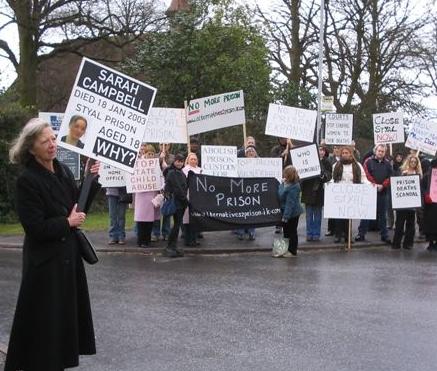“In the United Kingdom, forty per cent of sentenced women serve three months or less, and yet somehow manage to `harm themselves’ at a rate of three incidents per inmate. Women prisoners’ self harm is neither epidemic nor outbreak. It’s life. It’s part of the harm of being a woman in a neoliberal political economy. The Corston Report: a review of women with particular vulnerabilities in the criminal justice system, a review of women with particular vulnerabilities in the U.K. criminal justice system, said as much in March, 2007. Behind the Corston Commission Report sits HMP Styal, `one of the largest women’s prisons’ in the U.K. Between August 2002 and August 2003, six women died at Styal … That was then. This is now. February 27, 2009: `The chief inspector of prisons has warned of more deaths at Styal women’s prison if services for vulnerable inmates do not improve…. John Gunn, brother of Lisa Marley, who died at Styal in January last year, asked: `How many more women have to die before something is done?’” That was then, ten years ago, to the day. This is today: From February 2018 to May 2019, four women have died at HMP Styal: Nicola Birchall, 41, February 2018; Imogen Mellor, 29, June 2018; Christine MacDonald, 56, March 2019; Susan Knowles, 48, May 2019. None of the deaths was treated as suspicious. BBC News reports, “The latest HM Inspectorate of Prisons’ report, in May 2018, was positive.”
Here is what “positive” looks like: “95% of women said that they had problems on arrival. 53% said they had a problem with illicit drugs on arrival and 27% had an alcohol problem. 72% reported having a mental health problem. There were 735 incidents of self-harm in the six months to March 2018. Four women were transferred under the Mental Health Act in the six months to March 2018. 65% of women released who were not on home detention curfew did not have sustainable accommodation. Some women had been in and out of custody up to 11 times in 12 months.” Positive.
According to the most recent Safety in Custody Statistics, England and Wales, the general picture for incarcerated women, including remand prisoners, is equally grim: “Self-harm trends differ considerably by gender, with a rate of 570 incidents per 1,000 in male establishments (with incidents up 25% on the previous year) compared to a rate of 2,675 per 1,000 in female establishments (an increase of 24% in the number of incidents from the previous year). In the 12 months to December 2018, the number of self-harm incidents per self-harming prisoner was 4.0 for males, and 8.3 for females, increases from 3.5 and 7.0 respectively in 2017.” The majority of self-harm happens to those who have been in custody 31 days to 3 months.
The latest Inspectorate report on HMP Styal was positive concerning the prison’s attempt to follow recommendations from earlier reports, but the situation remains dire, and that’s the point. The individual deaths of Nicola Birchall, Imogen Mellor, Christine MacDonald, and Susan Knowles are suspicious, as are the high rates of self-harm.
In 2007, Baroness Corston noted, “There are many women in prison, either on remand or serving sentences for minor, non-violent offences, for whom prison is both disproportionate and inappropriate. Many of them suffer poor physical and mental health or substance abuse or had chaotic childhoods. Many have been in care … I have been dismayed at the high prevalence of institutional misunderstanding within the criminal justice system of the things that matter to women and at the shocking level of unmet need … There can be few topics that have been so exhaustively researched to such little practical effect as the plight of women in the criminal justice system.”
That was 2007, sparked by conditions in HMP Styal. It’s 2019, and still few topics have been so exhaustively researched to such little practical effect as the plight of women in the criminal justice system. Every death, injury, harm, unmet need, vulnerability is suspicious and should be treated as such. What happened to Nicola Birchall, Imogen Mellor, Christine MacDonald, and Susan Knowles? Nothing. There is nothing celebrate here.

